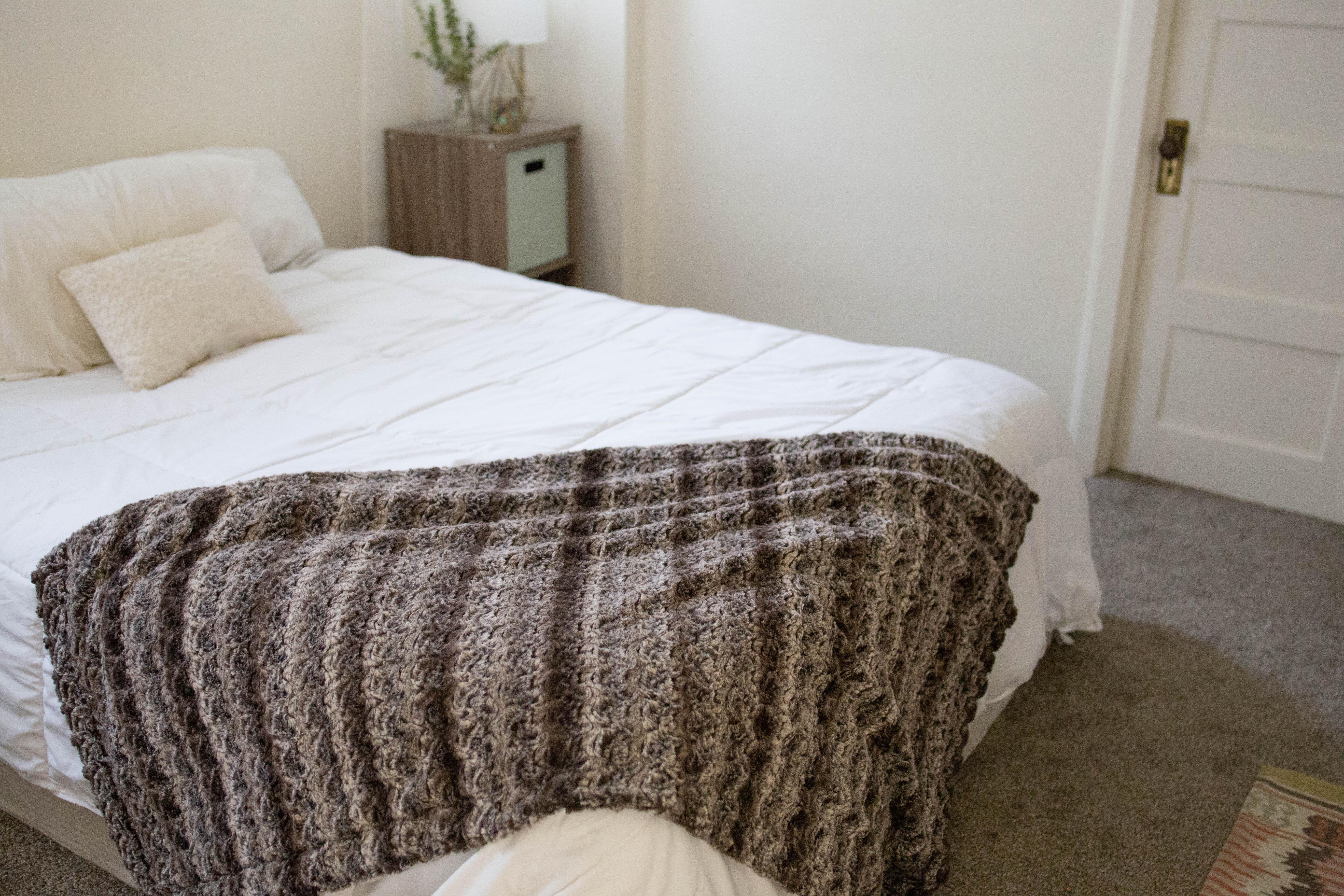That cozy throw blanket you’ve been snuggling up to all winter long? It’s probably time to wash it. Even if you haven’t spilled anything on it and can’t see (or smell) any messes, the coziest blankets are notorious for collecting dirt, dust, and germs over time. No matter what type of blanket you have—minky, fleece, electric, or wool—a regular cleaning routine will keep it fresh and free from oils, dry skin, dust, and more.
How often should you wash your blankets? It depends on what kind you have and how much you use it. Once a week is recommended for most blankets, though if you don’t use it often, every two weeks is okay. Let’s take a look at common types of throw blankets and how to wash them.
1. How to Wash Fleece and Fuzzy Throw Blankets
The trick to washing fuzzy blankets—fleece, faux fur, microfiber, etc.—is in getting them clean while keeping them soft, cuddly, and fuzzy.
Wash Cycle
Wash these types of blankets separately from other laundry in a cold-water, gentle cycle with a tiny bit of detergent. This will prevent pilling and matting. Fleece is naturally resistant to stains, so a simple cold water wash should get it nice and clean.
Drying
Don’t dry your fleece blanket in the dryer on high heat—that can cause the fibers to shrink or even melt. Instead, hang the blankets up to dry or use a no-heat cycle.
2. How to Wash a Wool Blanket
You might be surprised about how often you should wash your blankets made from wool. Wool fabric naturally repels dirt and stains, so even if you use your blanket frequently, you only need to wash it a few times each year. You could do a wash every quarter or even every six months. Some wool blankets are dry-clean only, so less frequent washes can help save money. Between washes, keep it fresh by shaking it out and removing debris with a soft fabric brush.
Wash Cycle
When it’s time to wash your wool blanket, use a gentle cold-water cycle and detergent that is safe for wool and delicate fabrics. With wool, you can’t just sit the blanket in the washer and forget it—you need to adjust the cycle yourself a bit. Before washing, soak your blanket in cold water with detergent for 15 minutes, either in your washer or a bathtub. Let the gentle cycle run for two minutes, then immediately switch to rinse.
Drying
The dryer can make wool blankets shrink and feel scratchy. Always hang a wool blanket out to dry, but keep it away from sunlight, which can fade the colors. Don’t ring the blanket out, either: If you need to, roll it in a towel and gently squeeze it to get out extra moisture before hanging it to dry.
3. How to Wash an Electric Blanket
Don’t worry: Washing an electric blanket won’t ruin it—these blankets are designed to be cleaned in the washing machine. Make sure you disconnect it from all cords and controls before washing.
Wash Cycle
To protect the wiring inside your blanket, choose the gentlest cycle your washing machine has. Use cold water and detergent, but avoid bleach and fabric softeners. Remove the blanket as soon as the cycle finishes.
Drying
You can put your electric blanket in the dryer, but make sure to use a low or no-heat setting, as high heat can damage the wiring. Keep it in for only 10 minutes, then hang it up to air dry by draping it over a clothesline or shower rod. You can also skip the dryer and air dry only. Don’t plug the blanket back in until it is completely dry!
4. How to Wash Minky Blankets
Minky blankets are so soft and snuggly that you might worry washing will ruin the unique texture. But once you know how to wash minky blankets the right way, you can keep yours plush and clean.
Wash Cycle
Always wash a handmade minky blanket by itself, using a delicate setting with cold water. The best option for detergent is as natural as you can find: Avoid detergents with dyes, scents, and fabric softeners. You can find natural, additive-free detergents at the store, or make your own (find out how, plus more tips for the care and washing of minky blankets). Never add fabric softener, which, ironically, makes the blankets less soft.
Drying
You can hang-dry your minky blankets for best results. If you’re short on time or space, you can tumble-dry them with no heat—just make sure to add dryer sheets (without fabric softeners) or wool balls to reduce static.
Keep Your Blankets Soft
Wash your blankets right to keep them clean, soft, snuggly, and in good condition for years to come.
Want to add a minky blanket to your collection? Check out our quality, handmade minky blankets.

Share:
What Are Minky Fabric Blankets Made From?
6 Stylish Ways to Display Minky Blankets on Your Couch